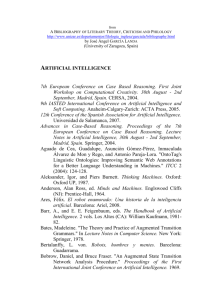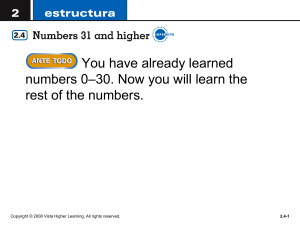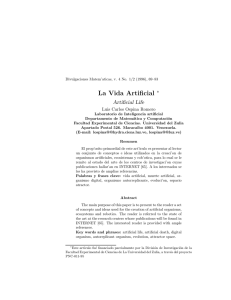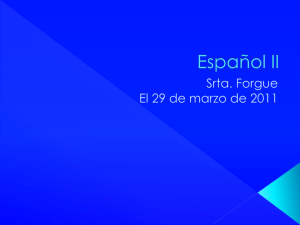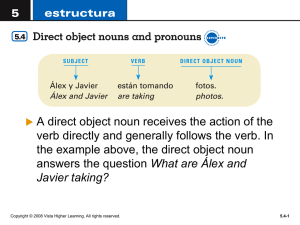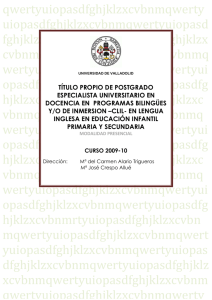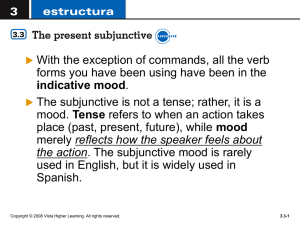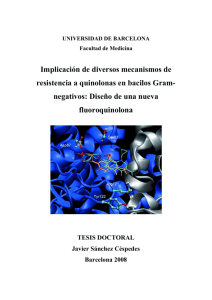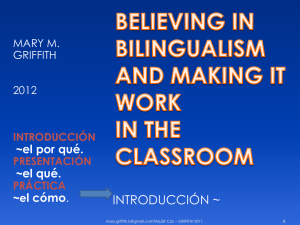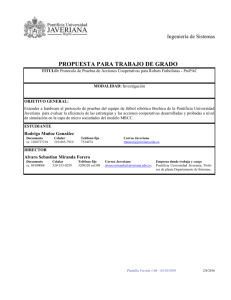References - GEOCITIES.ws
advertisement
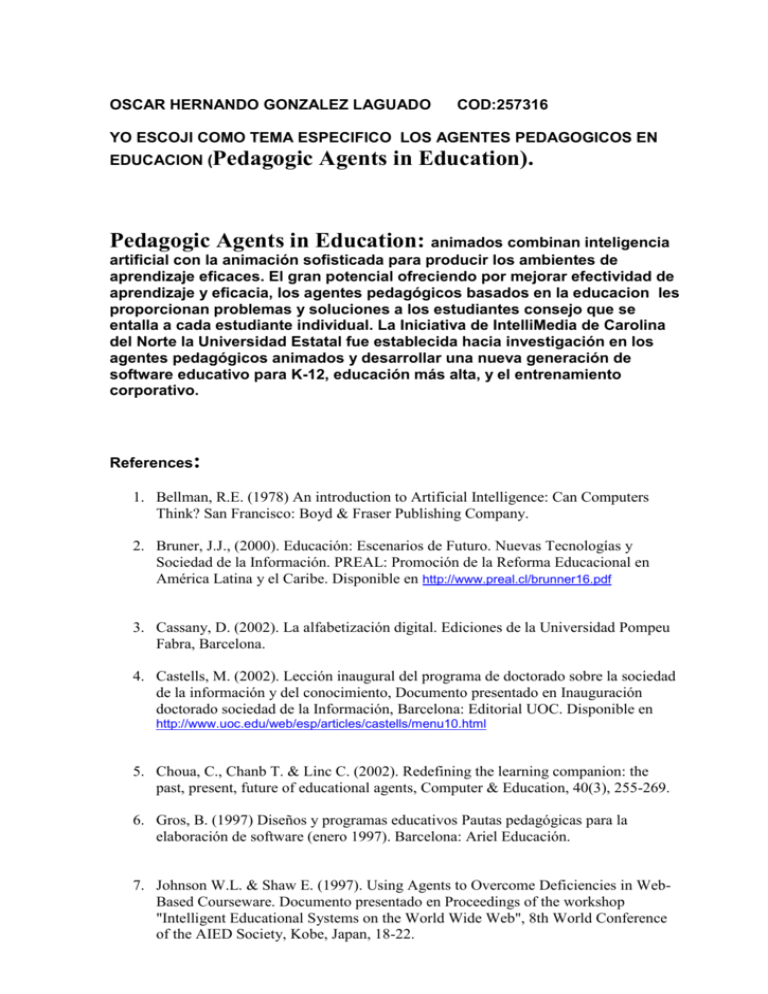
OSCAR HERNANDO GONZALEZ LAGUADO COD:257316 YO ESCOJI COMO TEMA ESPECIFICO LOS AGENTES PEDAGOGICOS EN EDUCACION (Pedagogic Agents in Education). Pedagogic Agents in Education: animados combinan inteligencia artificial con la animación sofisticada para producir los ambientes de aprendizaje eficaces. El gran potencial ofreciendo por mejorar efectividad de aprendizaje y eficacia, los agentes pedagógicos basados en la educacion les proporcionan problemas y soluciones a los estudiantes consejo que se entalla a cada estudiante individual. La Iniciativa de IntelliMedia de Carolina del Norte la Universidad Estatal fue establecida hacia investigación en los agentes pedagógicos animados y desarrollar una nueva generación de software educativo para K-12, educación más alta, y el entrenamiento corporativo. References: 1. Bellman, R.E. (1978) An introduction to Artificial Intelligence: Can Computers Think? San Francisco: Boyd & Fraser Publishing Company. 2. Bruner, J.J., (2000). Educación: Escenarios de Futuro. Nuevas Tecnologías y Sociedad de la Información. PREAL: Promoción de la Reforma Educacional en América Latina y el Caribe. Disponible en http://www.preal.cl/brunner16.pdf 3. Cassany, D. (2002). La alfabetización digital. Ediciones de la Universidad Pompeu Fabra, Barcelona. 4. Castells, M. (2002). Lección inaugural del programa de doctorado sobre la sociedad de la información y del conocimiento, Documento presentado en Inauguración doctorado sociedad de la Información, Barcelona: Editorial UOC. Disponible en http://www.uoc.edu/web/esp/articles/castells/menu10.html 5. Choua, C., Chanb T. & Linc C. (2002). Redefining the learning companion: the past, present, future of educational agents, Computer & Education, 40(3), 255-269. 6. Gros, B. (1997) Diseños y programas educativos Pautas pedagógicas para la elaboración de software (enero 1997). Barcelona: Ariel Educación. 7. Johnson W.L. & Shaw E. (1997). Using Agents to Overcome Deficiencies in WebBased Courseware. Documento presentado en Proceedings of the workshop "Intelligent Educational Systems on the World Wide Web", 8th World Conference of the AIED Society, Kobe, Japan, 18-22. 8. Johnson W.L, Rickel J.W. & Lester J.C. (2000). Animated Pedagogical Agents: Face-to-Face Interaction in Interactive Learning Environments, International Journal of Artificial Intelligence in Education, 11(2000), 47-78. 9. Murray T., Condit C., Piemonte J., Shen T. & Khan S. (2000). Evaluating the Need for Intelligence in an Adaptive Hypermedia System, Documento presentado en ITS Montréal 2000. 10. Naciones Unidas (2001) Informe Anual para el Desarrollo Humano, Poner el adelanto tecnológico al servicio del desarrollo humano. Nueva York: Ediciones Mundi-Prensa. Disponible en http://www.undp.org/hdr2001/spanish/ 11. Naciones Unidas (1998). Informe Anual para el Desarrollo Humano, Consumo para el desarrollo. Nueva York: Ediciones Mundi-Prensa. 12. Nagel, G.K. (2002). Building Cultural Understanding and Communication: A Model in Seven Situations. Disponible en http://www.readingonline.org/newliteracies/lit_index.asp?HREF=/newliteracies/nagel 13. Negroponte, N (1995) El Mundo digital. Barcelona: Ediciones B. 14. Pérez T.A., Gutiérrez J., López R., González A. & Vadillo J. A. (2001). Hipermedia, adaptación, constructivismo e instructivismo. Revista Iberoamericana de Inteligencia Artificial, 3(2), 29-38. 15. Poole, B. (1999) Tecnología Educativa. Educación para la sociedad de la comunicación y del conocimiento, Madrid: Mc Graw Hill. 16. Ryokai, K., Vaucelle, C., & Cassell, J. (2002a). Literacy Learning by Storytelling with a Virtual Peer. Documento presentado en In Proceedings of Computer Support for Collaborative Learning 2002. Disponible en http://web.media.mit.edu/~justine/publications.html 17. Ryokai, K., Vaucelle, C. & Cassell, J. (2002b). Virtual Peers as Partners in Storytelling and Literacy Learning. Journal of Computer Assisted Learning. 18. UNESCO (2000). Informe Mundial sobre la Comunicación y la Información 19992000 (Academy for Educational Development). Washington DC.: Wadi D. Haddad & Alexandra Draxler. 19. SEDICI (2000). Métrica de la Sociedad de la Información. Datos 1999-2000. SEDICI Asociación Española de Empresas de Tecnología de la Información. Disponible en http://www.campus-oei.org/salactsi/Metrica.PDF 20. Vallverdú, F., Sancho T., Mor E., Santanach, F. & Abad, A. (1998). Agentes Inteligentes y Libros Digitales, Barcelona: Ediciones UOC. Disponible en http://cv.uoc.es/~grc0_000252_web/Articles/Pon_Huelva.PDF 21. James C. Lester, Brian A. Stone, Michael A. O'Leary, Robert B. Stevenson: Focusing Problem Solving in Design-Centered Learning Environments. Intelligent Tutoring Systems 1996: 475-483 22. James C. Lester, Patrick J. Fitzgerald, Brian A. Stone: The Pedagogical Design Studio: Exploiting Artifact-Based Task Models for Constructivist Learning. Intelligent User Interfaces 1997: 155-162 23. Brian A. Stone, James C. Lester: Dynamically Sequencing an Animated Pedagogical Agent. AAAI/IAAI, Vol. 1 1996: 424-431 24. Karl Branting, James C. Lester, Bradford W. Mott: Dialogue Management for Conversational Case-Based Reasoning. ECCBR 2004: 77-90 25. Claude Frasson, Kaska Porayska-Pomsta, Cristina Conati, Guy Gouardères, W. Lewis Johnson, Helen Pain, Elisabeth André, Timothy W. Bickmore, Paul Brna, Isabel Fernández de Castro, Stefano A. Cerri, Cleide Jane Costa, James C. Lester, Christine L. Lisetti, Stacy Marsella, Jack Mostow, Roger Nkambou, Magalie Ochs, Ana Paiva, Fábio Paraguaçu, Natalie K. Person, Rosalind W. Picard, Candice Sidner, Angel de Vicente: Workshop on Social and Emotional Intelligence in Learning Environments. Intelligent Tutoring Systems 2004: 913 26. Yehya Mohamad, Stefanie Hammer, Fritz Haverkamp, Meinolf Nöker, Holger Tebarth: Evaluational Study: Training with Animated Pedagogical Agents. ICCHP 2002: 117-124 27. Yehya Mohamad, Stefanie Hammer, Fritz Haverkamp, Meinolf Nöker, Holger Tebarth: First Evaluational Results in the Development of Training by Animated Pedagogical Agents (TAPA). Mensch & Computer 2002 28. Berners-Lee, T., R. Fielding, and H. Frystyk. ``Hypertext Transfer Protocol -HTTP/1.0.'' RFC:1945. http://info.internet.isi.edu:80/innotes/rfc/files/rfc1945.txt. May 1996. 29. Cormen, Thomas H., Charles E. Leiserson, and Ronald L. Rivest. Introduction to Algorithms. McGraw-Hill, New York, N.Y., 1997. 30. Crossley, John. ``IP Network Index.'' http://ipindex.dragonstar.net. 22 Dec. 1997. 31. Fielding, R., J. Gettys, J. Mogul, H. Frystyk, L. Masinter, P. Leach and T. BernersLee. ``Hypertext Transfer Protocol -- HTTP/1.1.'' INTERNET-DRAFT. http://www.w3.org/Protocols/HTTP/1.1/draft-ietf-http-v11-spec-rev-06.txt. 18 Nov. 1998. 32. Fielding, R., J. Gettys, J. Mogul, H. Frystyk, and T. Berners-Lee. ``Hypertext Transfer Protocol -- HTTP/1.1.'' RFC: 2068. http://info.internet.isi.edu:80/innotes/rfc/files/rfc2068.txt. Jan. 1997. 33. Foster, L.S. C by Discovery. Scott/Jones, El Granada, Calif., 1994. 34. Hekman, Jessica Perry. LINUX in a Nutshell. O'Reilly, Sebastopol, Calif., 1997. 35. Ingargiola, Giorgio P. ``Search.'' http://yoda.cis.temple.edu:8080/UGAIWWW/lectures97/search. 1 Dec. 1998. 36. Kantrowitz, Mark. ``Artificial Intelligence FAQ.'' http://www.cs.cmu.edu/Groups/AI/html/faqs/ai/ai_general/top.html. 10 Aug. 1997. 37. Koster, Martijn. ``A Standard for Robot Exclusion.'' http://info.webcrawler.com/mak/projects/robots/norobots.html. 30 Nov. 1998. 38. Koster, Martijn. ``Guidelines for Robot Writers.'' http://info.webcrawler.com/mak/projects/robots/guidelines.html. 30 Nov. 1998. 39. Koster, Martijn. ``The Web Robots Database.'' http://info.webcrawler.com/mak/projects/robots/active.html. 30 Nov. 1998. 40. Koster, Martijn. ``The Web Robots FAQ.'' http://info.webcrawler.com/mak/projects/robots/faq.html. 30 Nov. 1998. 41. Koster, Martijn. ``The Web Robots Pages.'' http://info.webcrawler.com/mak/projects/robots/robots.html. 30 Nov. 1998. 42. Metcalfe, Vic, Andrew Gierth, et al. ``Programming UNIX Sockets in C Frequently Asked Questions.'' http://www.ibrado.com/sock-faq/html/unixsocket-faq.html. 21 May 98. 43. Radev, Dragomir R. ``Natural Language Processing FAQ.'' http://www.cs.columbia.edu/~acl/nlpfaq.txt. 23 Dec. 1996. 44. Russell, Stuart, and Peter Norvig. Artificial Intelligence A Modern Approach. Prentice Hall, Upper Saddle River, N.J., 1995. 45. Schildt, Herbert. C: The Complete Reference. McGraw-Hill, Berkeley, Calif., 1987. 46. Tanenbaum, Andrew S. Computer Networks. 3rd Ed. Prentice Hall, Upper Saddle River, N.J., 1996. 47. Watters, Aaron, Guido van Rossum, and James C. Ahlstrom. Internet Programming with Python. M&T Books, New York, N.Y., 1996. 48. Baray, C. Evolving cooperation via communication in homogeneous multi-agent systems in Proceedings of Intelligent Information Systems (Dec. 1997, Freeport, Bahamas) IEEE Computer Society, Los Alamitos, CA. 1997. pp 204-208. 49. Batali, J. Computational Simulations of the Emergence of Grammar, in Hurford, Studdert-Kennedy, Knight, (eds.), Approaches to the Evolution of Language, Cambridge, 1998. http://cogsci.ucsd.edu/~batali/papers/grammar.html 50. Braitenburg, V. Vehicles. MIT Press, Cambridge, MA. 1984. 51. Brooks, R. A Robot That Walks : Emergent Behaviors from a Carefully Evolved Network, in Neural Computation (pp 254-262). 52. Dyer, M. Toward synthesizing artificial neural networks that exhibit cooperative intelligent behavior: Some open issues in artificial life, in C. Langton (ed.), Artificial Life: An overview, MIT Press, MA, 1995, pp. 111-134. 53. Goldberg, D. Genetic algorithms in Search, Optimization and Machine Learning. Addison-Wesley, Reading, MA, 1989. 54. Hinton, G.E. and Nowlan, S.J.. How learning can guide evolution, in Complex Systems 1 (1987), pp. 495-502. 55. Hofstadter, D. Godel, Escher, Bach: An eternal golden braid. Basic Books, NY, 1979. 56. Holland, J. Hidden Order: How adaptation builds complexity Helix Books, Reading, MA, 1995. 57. Levy, S. Artificial Life: The quest for a new creation Jonathan Cape, London, 1992. 58. MacLennan, B. and Burghardt, G. Synthetic Ethology and the Evolution of Cooperative Communication, in Adaptive Behavior 2, 2 (Fall 1993), 161-188. http://www.cs.utk.edu/~mclennan/alife.html 59. Minsky, M. The Society of Mind. Simon and Schuster, NY, 1985. 60. Mitchell, M. An Introduction to Genetic Algorithms. MIT Press, Cambridge, MA, 1996. 61. Nilsson, N. Artificial Intelligence: A new synthesis. Morgan Kaufmann, San Francisco, CA, 1998. 62. Oliphant, M. and Batali, J.. Learning and the emergence of coordinated communication, in Center for Research on Language Newsletter 11, 1, (1997). http://www.ling.ed.ac.uk/~oliphant/papers/learnabs.html 63. Parisi, D. An Artificial Life Approach to Language, in Brain and Language 59 (1997), 121-146. 64. Parker, G. Evolving Hexapod Gaits Using a Cyclic Genetic Algorithm in Proceedings of th IASTED International Conference on Artificial Intelligence and Soft Computing (July 1997, Banff, Canada) pp. 141-144. 65. Parker, G. Metachronal Wave Gait Generation for Hexapod Robots in Proceedings of the Seventh International Symposium on Robotics with Applications (May 1998, Anchorage, AK). 66. Parker, G. Generating Arachnid Robot Gaits with Cyclic Genetic Algorithms in Genetic Programming III 1998 pp. 576-583. 67. Rawlins, G. Slaves of the Machine : The Quickening of Computer Technology. MIT Press, Massachusetts, 1997. 68. Steels, L. Synthesising the Origins of Language and Meaning Using Co-evolution, Self-organization and Level Formation, in J. Hurford (ed.) Evolution of Human Language Edinbugh University Press, Edinbugh, 1997. 69. Todd, P., and Miller, G. Exploring Adaptive Agency I: Theory and methods for simulating the evolution of learning. In Connectionist Models: Proceedings of the 1990 Summer School Morgan-Kaufmann, San Mateo, CA, 1991, pp. 65-80. 70. Werner, G. and Dyer, M.. Evolution of Communication in Artificial Organisms, in C. Langton, C. Taylor, J. Farmer, and S. Rasmussen (eds.), Artificial Life II, SFI Studies in the Sciences of Complexity, vol. X Addison-Wesley, MA, 1991, pp. 659687. 71. Leonard Foner, "What's an Agent Anyway?", Agents Memo 93-01, Agents Group MIT Media Lab, 1993 72. Pattie Maes, Alan Wexelblat, CHI 96 Tutorial, "Software Agents", 1996 73. Jaron Lanier, "Agents of Alienation", Hotwired debate with Pattie Maes, July 1995 74. Benjamin Schneiderman, Institute for Systems Research, University of Maryland 75. Stéphane Zrehen: A Neural Architecture for Motivated Navigation Behavior in an Animat. 478-479 BibTeX 76. Bradley J. Rhodes: PHISH Nets: Planning Heuristically In Situated Hybrid Networks. 480-481 BibTeX 77. H. Van Dyke Parunak, Albert D. Baker, Steven J. Clark: The AARIA Agent Architecture: An Example of Requirements-Driven Agent-Based System Design. 482-483 BibTeX 78. Andrei Popescu-Belis: An Adaptive Multi-Agent System Based on "Neural Darwinism". 484-485 BibTeX 79. Yves Lespérance, Hector J. Levesque, Shane J. Ruman: An Experiment in Using Golog to Build a Personal Banking Assistant (Extended Abstract). 486-487 BibTeX 80. Michel Occello, Yves Demazeau: CELLO: An Agent Model with Real Time Constraints. 488-489 BibTeX 81. Paul Davidsson: Linearly Anticipatory Autonomous Agents. 490-491 BibTeX 82. Glenn S. Wasson, Gabriel J. Ferrer, Worthy N. Martin: Hide-and-Seek: Effective Use of Memory in Perception/Action Systems. 492-493 BibTeX 83. Ramon Mas, Ronan Boulic, Daniel Thalmann: Extended Grasping Behavior for Autonomous Human Agents. 494-495 BibTeX 84. Rob Barrett, Paul P. Maglio, Daniel C. Kellem: WBI: A Confederation of Agents that Personalize the Web. 496-499 BibTeX 85. Ralph Rönnquist, Chi Keen Low: Analysing Expert Assistants through Interaction Diagrams. 500-501 BibTeX 86. Stefan Conrad, Can Türker, Gunter Saake: Towards Agent-Oriented Specification of Information Systems. 502-503 BibTeX 87. Luc Emering, Ronan Boulic, Selim Balcisoy, Daniel Thalmann: Multi-Level Modeling and Recognition of Human Actions Involving Full Body Motion. 504-505 BibTeX 88. Jorge E. Sagula, Martin F. Puricelli, Gustavo J. Bobeff, Gastón M. Martin, Carlos E. Pis Diez: GALOIS: An Expert-Assistant Model. 506-507 BibTeX 89. Patrick Doyle, Barbara Hayes-Roth: An Intelligent Guide for Virtual Environments. 508-509 BibTeX 90. Analía Amandi, Ana Price: Towards Object-Oriented Agent Programming: The Brainstorm Meta-Level Architecture. 510-511 BibTeX 91. Kirstie L. Bellman, Christopher Landauer: A Note on Improving the Capabilities of Software Agents. 512-513 BibTeX 92. Ruth Aylett, Alex M. Coddington, David P. Barnes, Robert A. GhaneaHercock: Supervising Multiple Cooperating Mobile Robots. 514-515 BibTeX 93. Ipke Wachsmuth, Britta Lenzmann, Tanja Jörding, Bernhard Jung, Marc Erich Latoschik, Martin Fröhlich: A Virtual Interface Agent and its Agency. 516517 BibTeX 94. Juan D. Velásquez, Pattie Maes: Cathexis: A Computational Model of Emotions. 518-519 BibTeX 95. Fernando J. Corbacho, Michael A. Arbib: Schema-Based Learning: Towards a Theory of Organization for Biologically-inspired Autonomous Agents. 520-521 BibTeX 96. Patricia Charlton, Y. Chen, E. H. Mamdani, Olle Olsson, Jeremy V. Pitt, Fergal Somers, Annika Waern: An Open Agent Architecture for Integrating Multimedia Services. 522-523 BibTeX 97. Amedeo Cesta, Daniela D'Aloisi, Rodolfo Brancaleoni: Mixed-Initiative Agenda Management with Software Agents. 524-525 BibTeX 98. John L. Pollock: Taking Perception Seriously. 526-527 BibTeX 99. D. Jenkins, D. Livingstone, D. Maclean, A. Reglinski: Supporting SafetyRelated Projects with a Designer's Assistant. 528-529 BibTeX 100. Manuela M. Veloso, Peter Stone, Sorin Achim: A Layered Approach for an Autonomous Robotic Soccer System. 530-531 BibTeX 101. Yuji Takada, Takao Mohri, Hiroki Iciki, Masatoshi Shiouchi, Yuji Wada, Francis G. McCabe: A Multi-Agent Model for Schedule Navigation with Location Information. 532-533 BibTeX 102. Aaron Sloman: Synthetic Minds. 534-535 BibTeX 103. Kristinn R. Thórisson: Gandalf: An Embodied Humanoid Capable of RealTime Multimodal Dialogue with People. 536-537 BibTeX 104. Bruce Blumberg: Go with the Flow: Synthetic Vision for Autonomous Animated Creatures. 538-539 BibTeX 105. Benedita Malheiro, Eugenio Oliveira: Environmental Decision Support: a Multi-Agent Approach. 540-541 BibTeX 106. Haym Hirsh, Brian D. Davison: An Adaptive UNIX Command-Line Assistant. 542-543 BibTeX 107. Sanya Mitaim, Bart Kosko: Neural Fuzzy Agents for Profile Learning and Object Matching. 544-545 BibTeX 108. Peter Robinson: Autonomous Design and Execution of Process Controllers for Untended Scientific Instruments. 546-547 BibTeX
